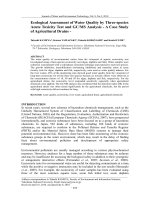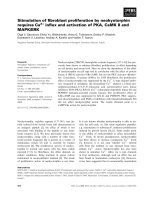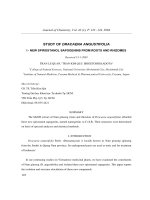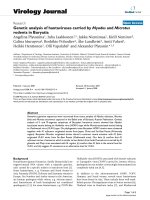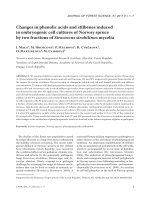Genetic study of hematopoiesis development by two zebrafish mutants ugly duckling and tc 244
Bạn đang xem bản rút gọn của tài liệu. Xem và tải ngay bản đầy đủ của tài liệu tại đây (2.47 MB, 165 trang )
GENETIC STUDY OF HEMATOPOIESIS DEVELOPMENT BY TWO
ZEBRAFISH MUTANTS: UGLY DUCKLING AND TC-244
DU LINSEN
NATIONAL UNIVERSITY OF SINGAPORE
2007
GENETIC STUDY OF HEMATOPOIESIS DEVELOPMENT BY TWO
ZEBRAFISH MUTANTS: UGLY DUCKLING AND TC-244
DU LINSEN
(B.Sc, Zhejiang University, China)
A THESIS SUBMITTED
FOR THE DEGREE OF DOCTOR OF PHILOSOPHY
DEPARTMENT OF BIOLOGICAL SCIENCES
NATIONAL UNIVERSITY OF SINGAPORE
i
ACKNOWLEDGMENTS
This thesis is the result of four years of research work whereby I have been
accompanied and supported by many people. It is pleasant that I finally have the
opportunity to express my gratitude for all of them.
The first person I would like to thank is my supervisor Dr Zilong WEN. I have
joined his lab since September 2003 when I did my second rotation project. During
these four years, his enthusiasm and integral view on research and his mission for
providing high-quality work has made a deep impression on me. I owe him lots of
gratitude for his supervision, advice, and guidance for this thesis project as well as the
encouragement and support in various ways. Besides of being an excellent supervisor,
he was as close as a friend, giving me lots of help and advice in my graduate life.
I would like to thank Dr Jinrong PENG who kept an eye on the progress of my
work in the last graduate semester and was always available when I needed his
advises. I would also like to thank the other members of my PhD committee who
monitored my work and took effort in reading and providing me with valuable
comments.
I want to thanks to all the members of WZL lab. Especially, Yanmei Liu and
Bernard Teo had contributed a lot to the udu project of my thesis. It is my pleasure to
work with them. I am also indebted to my fellow colleagues for their help and advice
for my project, they are Mei Huang, Feng Qian, Hao Jin, Jin Xu, Fenghua Zhen,
Augustine Cheong, Theodosia Tan, Chin Thing Ong, Darren Toh, and Wenqing
Zhang. I really enjoy working in the WZL family.
ii
Special thanks also go to Dr. Motomi Osato, who is our collaborator, and he
did the cell cycle and cytology analysis for the udu project. I also want to express my
sincere thanks to all the staffs in the zebrafish facility in Institute of Molecular and
Cell Biology for their excellent service.
Lastly, and most importantly, I feel a deep sense of gratitude for my parents
who have never ceased to support, encourage, and love me during my life. I feel so
lucky to be their daughter. Finally, I am very grateful for my husband Li Jing, for his
love, patience, encouragement, and advice. Without them, this thesis is not possible.
iii
Table of Contents
ACKNOWLEDGMENTS I
TABLE OF CONTENTS III
SUMMARY VIII
LIST OF TABLES X
LIST OF FIGURES XI
LIST OF ABBREVIATIONS XIII
LIST OF PUBLICATIONS XV
CHAPTER I INTRODUCTION 1
1.1 Current understanding of hematopoietic development 1
1.1.1 Hematopoiesis and hematopoietic cells 1
1.1.2 Model organisms of hematopoietic research 2
1.1.3 Origin of hematopoiesis 3
1.1.4 Hemangioblast 4
1.1.5 Distinct waves of hematopoiesis 5
1.1.6 Hematopoietic stem cell 8
1.1.7 Hematopoietic lineage commitment 9
1.1.7.1 Erythropoiesis 10
1.1.7.2 Myelopoiesis 14
1.1.7.3 Lymphopoiesis 16
1.2 Zebrafish as a model organism for hematopoietic research 18
1.2.1 Zebrafish as a new vertebrate model organism 18
iv
1.2.2 Hematopoiesis from zebrafish point of view 19
1.2.2.1 Primitive hematopoiesis 20
1.2.2.1.1 Primitive erythropoiesis 22
1.2.2.1.2 Primitive myelopoiesis 24
1.2.2.2 Definitive hematopoiesis 25
1.2.2.2.1 Definitive erythropoiesis 27
1.2.2.2.2 Definitive myelopoiesis 28
1.2.2.2.3 Lymphopoiesis 29
1.2.2.2.4 Thrombopoiesis 30
1.2.2.3. Adult hematopoiesis 31
1.3 Current genetic approaches used in zebrafish hematopoiesis research 33
1.3.1 Forward genetic approach 33
1.3.1.1 Mutagenesis screen 33
1.3.1.2 Genetic mapping 34
1.3.2 Reverse genetic approach 37
1.3.3 Transgenesis 38
1.4 Aims 39
CHAPTER II MATERIAL AND METHODS 42
2.1 Zebrafish biology 42
2.1.1 Zebrafish maintenance and strains used 42
2.1.2 Positional Cloning 42
2.1.2.1 Mapping cross 42
2.1.2.2 Preparation of genomic DNA 43
2.1.2.3 SSLP marker and PCR reaction 44
v
2.1.2.4 Initial mapping and bulk segregation analysis (BSA) 45
2.1.2.5 Fine mapping 45
2.1.2.6 Genomic walking 48
2.1.2.7 Sequencing mutation 49
2.1.3 Whole mount in situ hybridization (WISH) 51
2.1.4 Hemoglobin staining with o-dianisidine 52
2.1.5 Microinjection of Morpholino 53
2.1.6 Transplantation 54
2.1.7 Cryo-section 55
2.1.8 Whole mount cell death assay 55
2.1.8.1 Acridine orange staining 55
2.1.8.2 TUNEL assay 56
2.1.9 Whole mount immunofluorescent staining 56
2.1.10 Embryos preparation for flow cytometry analysis 57
2.1.11 May-Grunwald/Giemsa staining 58
2.2 General DNA application 59
2.2.1 Restriction endonuclease digestion 59
2.2.2 Recovery DNA fragment from agarose gel 59
2.2.3 Ligation and transformation 59
2.2.4 Plasmid DNA preparation 60
2.2.5 PCR and sub-cloning 61
2.3 RNA application 62
2.3.1 RNA extraction from zebrafish embryos 62
2.3.2 Reverse transcription and cDNA synthesis 63
vi
2.3.4 In vitro transcription 64
2.4 Yeast Biology 66
2.4.1 Yeast transformation 66
2.4.1.1 Small scale yeast transformation 66
2.4.1.2 Library scale yeast transformation 67
2.4.2 Yeast Colony PCR and sequencing of library inserts 68
2.4.4 Yeast plasmid isolation and transformation into E.coli 68
CHAPTER III THE NOVEL ZEBRAFISH UDU GENE IS ESSENTIAL FOR
PRIMITIVE HEMATOPOIETIC CELL DEVELOPMENT 70
3.1 Characterization of hematopoietic defects in udu
sq1
mutant 70
3.1.1 General morphological phenotype of udu
sq1
mutant 70
3.1.2 Primitive hematopoietic hypoplasia in udu
sq1
mutant 71
3.1.3 Primitive udu
sq1-/-
erythroid cells have impaired proliferation and
differentiation abilities. 75
3.2 udu gene functions cell autonomously in primitive erythropoiesis 79
3.3 Fishing out the interaction partners of Udu protein 82
3.4 Discussion 93
3.4.1 Function of udu gene in early embryogenesis 93
3.4.2 Identification of udu as a novel factor essential for primitive hematopoiesis
94
3.4.3 Cell autonomous role of udu gene in primitive hematopoiesis 96
3.4.4 The potential interaction partners of Udu protein 97
vii
CHAPTER IV CHARACTERIZATION AND POSITIONAL CLONING OF
ZEBRAFISH TC-244 MUTANT 99
4.1 tc-244 mutant exhibits a definitive specific phenotype 99
4.2 Positional Cloning of tc-244 mutant 105
4.2.1 tc-244 gene locates on linkage group 7 105
4.2.2 tc-244 gene is mapped to a novel zebrafish gene 109
4.3 Cloning the full-length of zgc153228 gene 113
4.4 Expression pattern of zgc153228 120
4.5 Morpholino knockdown of zgc153228 121
4.6 Discussion 124
4.6.1 tc-244 is a definitive hematopoietic mutant 124
4.6.2 Cloning of tc-244 mutant gene 125
4.6.3 Functional implication of tc-244 gene 127
CHAPTER V CONCLUSION 129
REFERENCE 133
viii
SUMMARY
Hematopoiesis is defined as a biological process that gives rise to all blood lineages in
the course of an organism’s lifespan. It is widely known that vertebrate hematopoiesis
has two phases: a “primitive” (embryonic) phase is followed by the other “definitive”
(adult) phase. The transient primitive wave of hematopoiesis initiates the circulation
and mainly give rise to primitive erythrocytes and a small portion of macrophages;
while the definitive wave of hematopoiesis generate all the blood lineages
continuously and gives rise to the fetal and adult peripheral blood cells. However, the
molecular mechanisms governing the generation and regulation of these two waves of
hematopoiesis are not fully understood. Recently zebrafish (Danio rerio) has emerged
as a pre-eminent model organism for vertebrate hematopoietic research due to its
genetic and embryological advantages.
This dissertation describes the genetic study of two zebrafish hematopoietic
mutants: ugly duckling (udu) and tc-244. Phenotypic analysis of udu
sq1
mutant allele
showed that udu gene was essential for primitive hematopoiesis development. Loss of
udu gene in zebrafish led to severe hematopoietic hypoplasia phenotype. Moreover,
FACS analysis revealed that this defect in primitive erythroid cells was caused by
their abnormal arrest in G2-M phase during cell cycle progression. Besides,
transplantation experiment showed that udu gene was cell autonomously required for
this function in primitive erythroid cells. Of note, a group of molecules that are known
to function in cell division or cell cycle regulation were fished out from yeast two-
hybrid screen as candidate interaction partners of Udu protein, thus further supporting
ix
the argument that Udu may be required for regulation of cell cycle progression in
primitive hematopoietic cells.
Unlike udu mutant, tc-244 mutant was normal in primitive hematopoiesis but
had severe defects in generation of definitive hematopoiesis. By whole mount in situ
hybridization analysis of hematopoietic specific markers, it was found that definitive
HSCs were initially specified in tc-244 mutants, but their further differentiation and
development were impaired, leading to the absence of major lineages of definitive
hematopoietic cells including erythroid, myeloid, and lymphoid cells. By positional
cloning approach, the tc-244 mutant gene was mapped to a novel zebrafish gene
zgc153228 on linkage group 7. Morpholino knockdown of zgc153228 showed similar
morphant phenotype as tc-244 mutant, confirming that the mutant phenotype of tc-
244 was indeed caused by loss of function of zgc153228 gene. Thus, zgc153228 is
identified as a novel factor critical for definitive hematopoiesis development.
In conclusion, by genetic analysis of zebrafish mutants udu and tc-244 in this
study, two novel genes (udu and tc-244) are identified as novel factors involved in the
regulation of primitive and definitive hematopoiesis development.
x
List of Tables
Table 1.1 Zebrafish hematopoietic mutants resembling human diseases 35
Table 1.2 Hematopoietic lineage specific transgenic zebrafish lines 39
Table 2.1 SSLP marker panel for initial mapping (linkage screening) 47
Table 2.2 Mapping primers list for tc-244 mutant 50
Table 2.3 Morpholinos used in this study 54
Table 2.4 RNA probes generated by in vitro transcription in this study and their
constructs information 65
Table 3.1 Summary of cell transplantation analysis 82
Table 3.2 Summary of clones from yeast two hybrid screen 89
xi
List of Figures
Figure 1.1 Tentative schemes of hematopoietic lineage commitment 10
Figure 1.2 Major hematopoiesis sites in zebrafish. 32
Figure 2.1 Principle of bulk segregation analysis (BSA) used in initial mapping. 46
Figure 2.2 Structures of DNA and morpholino oligonucleotides 53
Figure 3.1 Morphology of udu
sq1
mutant 71
Figure 3.2 Primitive erythroid hypoplasia of udu
sq1
mutant 73
Figure 3.3 Primitive myelopoiesis is defective in the udu
sq1
mutant 74
Figure 3.4 Acridine orange staining of cell death in udu
sq1
embryos 76
Figure 3.5 Primitive erythroid cells in udu
sq1-/-
mutant are defective in cell
proliferation and differentiation 78
Figure 3.6 Temporal and spatial expression of the udu gene during early zebrafish
development 80
Figure 3.7 Alignment of zebrafish Udu, human and mouse GON4L proteins 86
Figure 3.8 Domain structure of zebrafish Udu protein. 86
Figure 4.1 Morphology of tc-244 mutant 99
Figure 4.2 Primitive hematopoiesis is normal in tc-244 mutant 100
Figure 4.3 Lymphoid lineage development is defective in tc-244 mutant 101
Figure 4.4 Definitive erythroid and myeloid lineage development is defective in tc-
244 mutant 102
Figure 4.5 Definitive HSCs development is affected in tc-244 mutant 104
Figure 4.6 Linkage scanning of tc-244 mutant 106
Figure 4.7 Part of the genetic map of linkage group 7 108
Figure 4.8 Simplified contig676 is composed of a series of fully sequenced BACs
11111
Figure 4.9 The final 3-BAC region of genomic walk 11212
xii
Figure 4.10 A nonsense mutation is detected in zgc153228 gene 113
Figure 4.11 Alignment of two zgc153228 transcripts 116
Figure 4.12 zgc153228 has two forms of transcripts 117
Figure 4.13 Alignment of human IT1, mouse hypothetical protein LOC231123, and
zebrafish zgc153228 protein sequence 120
Figure 4.14 zgc153228 gene expresses ubiquitously during embryonic development
121
Figure 4.15 Morphant of zgc153228 mimicks tc-244 mutant phenotype 12323
xiii
List of Abbreviations
AGM aorta–gonad–mesonephros
a. a amino acid
ALM anterior lateral mesoderm
BAC bacterial artificial chromosome
bHLH basic helix-loop-helix
BL-CFC blast-colony-forming cells
BMP bone morphogenetic protein
BSA bulk segregation analysis
CHT caudal hematopoietic tissue
CLP common lymphoid progenitor
CMP common myeloid progenitor
CNS central nervous system
ctg contig
DA dorsal aorta
dpf days post fertilization
EGFP enhanced green fluorescent protein
ENU N-ethyl-N-nitrosourea
EPO glycoprotein hormone erythropoietin
ES embryonic stem
FACS fluorescent-activated cell sorting
GMP granulocyte/monocyte progenitor
Hh hedgehog signaling pathway
hpf hours post fertilization
xiv
HSC hematopoietic stem cell
ICM intermediate cell mass
MEP erythrocyte/megakaryocyte progenitor
MO morpholino phosphorodiamidate oligonucleotide
PAH paired amphipathic helix repeat
PBI posterior blood island
PCR polymerase chain reaction
PLM posterior lateral mesoderm
Pre-RC pre-replication complex
RBC red blood cell
RBI rostral blood island
RT-PCR reverse transcription polymerase chain reaction
SANT-L SW13, ADA2, N-Cor and TFIIIB-like domain
SNP single nucleotide polymorphism
SSLP simple-sequence length polymorphism
SSR simple sequence repeats
TGF-β transforming growth factor-β
TILLING target induced local lesions in genomes
TUNEL terminal transferase dUTP nick end labeling
udu
ugly duckling mutant
WGS whole genome shotgun
WISH whole mount in situ hybridization
Y2H yeast two hybrid screen
wt wild type
xv
List of Publications
Jin H, Xu J, Qian F, Du L, Tan CY, Lin Z, Peng J, Wen Z. 2006. The 5’ zebrafish scl
promoter targets transcription to the brain, spinal cord, hematopoietic and endothelial
progenitors. Dev Dyn 235:60-7
Liu Y, Du L, Osato M, Teo EH, Qian F, Jin H, Zhen F, Xu J, Guo L, Huang H, Chen
J, Geisler R, Jiang YJ, Peng J, Wen Z. 2007. The zebrafish udu gene encodes a novel
nuclear factor and is essential for primitive erythroid cell development. Blood 110:
99-106
Chapter I
1
Chapter I Introduction
1.1 Current understanding of hematopoietic development
1.1.1 Hematopoiesis and hematopoietic cells
Hematopoiesis is a word derived from ancient Greek (haima blood; poiesis to make)
which means the formation of blood. It is a biological process that produces all types
of blood cells throughout the lifetime of an animal. In general, hematopoietic cells can
be classified into three types: erythrocyte, leukocyte, and platelet. Erythrocytes or red
blood cells are the most abundant cell type, and they stay within the blood vessels and
transport oxygen and nutrition. Leucocytes or white blood cells mainly perform the
function to combat infection and sometimes phagocytose and digest debris, and there
are three categories of leukocytes: granulocyte, monocyte, and lymphocyte.
Leucocytes usually migrate across the walls of small blood vessels into tissues to
perform their tasks. Beside these two major cell types, blood also contains large
numbers of thrombocytes or platelets. They are small and detached cell fragments
derived from the giant megakaryocytes and adhere specifically to the endothelial cells,
and they help to repair damaged blood vessels and aid in blood clotting. Despite their
functional diversity, all these different types of hematopoietic cells are generated
ultimately from a common ancestor known as hematopoietic stem cells (HSCs)
(Kondo et al 2003).
The hematopoietic system has been extensively studied in the past few
decades due to its importance. On the one hand, understanding of hematopoiesis is
critical for clinical practice. Human diseases, such as anemia, leukemia,
Chapter I
2
immunodeficiency, and lymphoma are all caused by defects in this process.
Approaches to treat these disorders also require manipulation of hematopoietic cells.
For example, bone marrow transplantation or hematopoietic stem cell replacement
approach has been used to ameliorate the related diseases (Zon 2001). On the other
hand, mechanisms involved in the genesis of hematopoietic system also intrigue
scientists from a developmental viewpoint. The hematopoietic system is distinguished
from other organ systems by its unique feature that all the mature blood cells are
short-lived. Therefore, hematopoiesis needs to be continuous throughout life. This
astonishing feature is fascinating topics of developmental biology. Moreover,
hematopoiesis studies also set paradigms that are relevant to other parallel organ
systems. Therefore, better understanding of hematopoiesis will benefit both clinical
application and basic research.
1.1.2 Model organisms of hematopoietic research
The research of hematopoiesis began nearly a century
ago and had adopted many
different model organisms throughout its history.
Mouse model is the most
widely used system in hematopoietic research. The
most obvious advantage of the mouse model is because it is mammalian, while other
strengths also
include the availability of antibodies for the identification
and
purification of different classes of hematopoietic cells; the variety of in vitro and
in
vivo functional assays; and the availability of genetics and
genomics tools (de Bruijn
2005). Chicken and frog are the classical non-mammalian model organisms for
hematopoiesis research. The
chicken embryo has a long-standing history in study of
Chapter I
3
hematopoiesis, as its accessibility and flat morphology make it well suited
for the
grafting experiments. By grafting blastoderm of chickens onto the yolk of quail, it
was showed that the hematopoietic stem cells that last the lifetime were derived from
the mesodermal area surrounding the aorta (Dieterlen-Lievre & Martin 1981). The
unique feature that
made frog a valuable model organism for developmental
hematopoiesis
is the clear spatial separation of primitive and definitive
hematopoiesis,
which takes place in the ventral blood islands
and dorsal lateral plate mesoderm
respectively (Ciau-Uitz et al 2000). This spatial
separation allows for the detailed
analysis of the developmental
origin of these two distinct cell populations. In addition,
similar to the chicken, the externally
development of the embryos makes it possible to
perform grafting
experiments to examine the hematopoietic potential of various
mesodermal tissues.
By studying all these model organisms, the major program of hematopoiesis is
found to be conserved throughout vertebrate evolution. Details of this conserved
process will be reviewed in the following sections to reveal our current understanding
of hematopoiesis development.
1.1.3 Origin of hematopoiesis
Early events that lead to hematopoiesis were first revealed by fate mapping in
Xenopus laevis. It has been shown that the blood fate map domain occupies the
vegetal portion of the marginal zone early at 32-cell stage embryo (Lane & Smith
1999). The marginal zone is the equatorial region of the blastula embryo, and, it will
Chapter I
4
pattern to form mesoderm that later gives rise to tissues such as notochord, somites,
kidney and blood during gastrulation. Transplantation experiment between
cytogenetically distinct embryos further suggests only ventral marginal zone is
induced to form the hematopoietic tissue (Turpen et al 1997). Members of the TGF-
β-related BMP family have been shown to be critical for this induction event. Over-
expression of bmp2, bmp4, bmp7 perturbs normal mesodermal patterning by causing
an expansion of ventral mesodermal fates at the expense of more dorsal derivatives
(Clement et al 1995; Dale et al 1992; Fainsod et al 1994; Jones et al 1992; Wang et al
1997). Conversely, over-expression of a dominant-negative BMP receptor or
inhibition of bmp4 expression shows an opposite phenotype (Graff et al 1994; Sasai et
al 1995; Smith 1995). Similar result was also obtained in Bmp4 knockout mice
(Winnier et al 1995), confirming that the vertebrate hematopoiesis arises from ventral
mesoderm.
1.1.4 Hemangioblast
Following gastrulation, a population of ventral mesoderm cells will migrate to the
embryonic yolk sac and form blood islands which consist of two lineages of cells, a
population of erythroid cells surrounded by a layer of vascular endothelial cells. This
phenomenon had lead to the speculation of a common origin for blood and vascular
tissue and the existence of a bipotential precursor hemangioblast (Pardanaud et al
1989). In vitro culture studies of mouse embryonic stem (ES) cells have provided
more concrete evidence in support of this hemangioblast concept. Choi and co-
workers had described the isolation of blast-colony-forming cells (BL-CFC) from
Chapter I
5
embryoid bodies which arise during culture of embryonic stem cells (Kennedy et al
1997). When BL-CFCs were cultured in the presence of appropriate cytokines, they
could give rise to both hematopoietic and endothelial cells (Choi et al 1998; Robb &
Elefanty 1998). Furthermore, hematopoietic stem cells and endothelial cells have
similar surface marker and gene expression, including CD34, transcription factors
stem cell leukemia gene (Scl), and vascular endothelial growth factor receptor Flk1
(Amatruda & Zon 1999). Scl is known to be essential for embryonic hematopoiesis,
but it was also found to play a role in angiogenesis through analysis of chimeric Scl
-/-
mice expressing a transgene targeting lacZ to vessels (Visvader et al 1998). Mice
bearing null mutations of Flk1 also have profound defects in both hematopoiesis and
vasculogenesis (Shalaby et al 1997). Although all these finding support the existence
of hemangioblast, the unequivocal proof for this hypothesis awaits the further
evidence such as cell tracing experiment. Moreover, isolation of these cells and
characterization of their potential will be necessary to formally demonstrate that they
represent the hemangioblasts (Keller et al 1999).
1.1.5 Distinct waves of hematopoiesis
In vertebrate, development of hematopoietic lineage is complex, as it occurs in two
waves: a primitive or embryonic wave of hematopoiesis is followed by the other
definitive or adult wave of hematopoiesis.
In mammal and avian, the first blood cell population is formed in yolk sac, an
extra-embryonic structure, which is the site of primitive hematopoiesis. The
analogous region in amphibians is the ventral blood island. This transient wave of
Chapter I
6
hematopoiesis will initiate the circulation and mainly give rise to primitive red blood
cells and a small portion of macrophages. These primitive erythrocytes differ from
those found in the fetal liver and adult bone marrow in that they are large, mainly
nucleated, and produce the embryonic forms of globin (Barker 1968; Brotherton et al
1979). The only other hematopoietic cells present in the early yolk sac are
macrophages (Cline & Moore 1972). They mature rapidly and express lower levels of
some marker genes suggesting that they could represent a unique population of
macrophages (Faust et al 1997; Keller et al 1999).
During further development, the primitive wave is replaced by the definitive
wave of hematopoiesis, which can generate all the blood lineages including erythroid,
myeloid and lymphoid lineages and gives rise to the fetal and adult peripheral blood
cells (Amatruda & Zon 1999). It is widely accepted that definitive hematopoiesis is
derived from an intraembryonic location known as the aorta–gonad–mesonephros
(AGM) region. Classical experiments in the chick-quail transplantation system,
complemented by those that used diploid-triploid Xenopus chimeras, has traced the
origins of definitive hematopoiesis to the cells of the AGM region (Chen & Turpen
1995). Transplantation of quail yolk sac to chick embryo showed that definitive
hematopoiesis was exclusively of chick origin, thereby establishing the principle of
intra-embryonic hematopoiesis (Lassila et al 1982). In the Xenopus embryo,
transplantation of the dorso-lateral plate (the equivalent of the AGM) from a diploid
to a reciprocal triploid embryo found diploid cells in the larval and adult blood (Chen
& Turpen 1995). Although similar transplant studies are not feasible in mouse model,
HSC activity is detectable after embryonic day 11 (E11) in the AGM region of mice
upon transplantation of these cells to an irradiated adult recipient (Medvinsky et al
Chapter I
7
1993). Definitive hematopoietic cells do not differentiate in situ in AGM, but travel to
a fetal site of hematopoiesis. In mammals, fetal blood formation occurs in the liver
and spleen while the adult site is bone marrow.
However, the relationship between the primitive and definitive hematopoiesis
remains unclear and has been the subject of intense investigation. Several groups
using in vitro differentiation model has suggested that these two lineages share a
common precursor (Keller et al 1998; Kennedy et al 1997; Turpen et al 1997). Recent
finding showing that yolk sac can contribute to the definitive hematopoiesis in vivo
also support this argument (Samokhvalov et al 2007). But the fate mapping analysis in
xenopus clearly indicated that embryonic and adult blood was derived from distinct
blastomeres in the 32-cell embryo (Ciau-Uitz et al 2000). Thus, the origin of two
waves of hematopoiesis is still controversial. Besides their origination, primitive and
definitive hematopoiesis development also seems to be controlled by distinct
molecular programs, as gene targeting experiments of two transcription factor c-Myb
-/-
and Runx1
-/-
mice both show normal yolk sac development but severely impaired
definitive hematopoiesis (Mucenski et al 1991; Okuda et al 1996). Several other genes
are also found to be preferentially utilized by the definitive program as well (Kitajima
et al 1999; Porter et al 1997). In contrast, our understanding of the molecular
mechanism that specify the primitive hematopoiesis development is poor, as analysis
of definitive hematopoiesis in mice with targeted alleles of essential primitive specific
genes could be complicated by early embryonic death, due to lack of primitive
hematopoiesis (Keller et al 1999).
Chapter I
8
1.1.6 Hematopoietic stem cell
The most significant feature of definitive hematopoiesis is to generate all the lineages
of blood cells continuously. And this ability depends very much on the hematopoietic
stem cells (HSCs), which are pluripotent cells capable of self-renewal and
differentiation into all hematopoietic lineages (Weissman 2000). The original pool of
HSCs is formed during embryogenesis in a complex developmental process that
involves several anatomical sites, which finally colonize the bone marrow at birth. In
mouse, one and a half days after blood islands appear, at about the time the yolk-sac
blood vessels connect to the embryo proper, blood formation in the embryo is first
observed at or near the ventral wall of dorsal aorta in the AGM region (Cumano et al
2001). Blood-forming activity attributed to haematopoietic stem cells (HSCs) is
evident in this region at around E10.5 (Medvinsky & Dzierzak 1996). Although the
AGM region is recognized as the site where definitive HSC activity is detected, the
origin of definitive HSCs is still unclear: whether they are produced de novo in this
intraembryonic region or they are yolk sac origin and are induced to become
definitive HSCs after they enter the AGM. The later possibility is supported by the
recent finding that Runx1-positive yolk-sac cells do form at least part of the definitive
HSCs that can contribute to the adult hematopoiesis by using an elegant cell labeling
approach (Samokhvalov et al 2007). More complexly, mammalian placenta has been
recently recognized as a niche for definitive HSCs. A striking feature of placental
HSCs is the rapid expansion of HSC pool between E11.5 and E12.5. As a result, the
placenta harbors over 15-fold more HSCs than does the AGM region or the yolk sac,
suggesting that the placenta may provide a unique microenvironment for HSC
